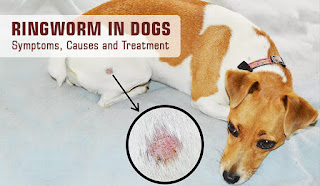With worms like tapeworms, hookworms and roundworms being the most popular culprits in the lives of our dogs, one may obviously conflate ringworms in the same category, but that isn’t it. Despite the fact that it has the word “worms” in its name, ringworms are not worms. Surprisingly, ringworm is a fungus, a highly contagious fungus that can affect both animals and humans.
You can avoid the spread of ringworm if you diagnose it at its early onset. Here’s all you need to know about ringworms in dogs.
What is ringworm in dogs?
Ringworm is a fungal infection that occurs in the superficial layers of skin, hair and nails. Since the fungi that cause ringworm infections are classified into a specialized group called dermatophytes, the medical term for this condition is known as dermatophytosis. The three common fungal species that cause ringworm in dogs are Microsporum canis, Microsporum gypseum and Trichophyton mentagrophytes. These species of ringworm are zoonotic, so they can also infect humans.
What does a ringworm infection look like?
The name “ringworm” originates from the way the skin looks when it is infected: a circular, red, raised rash that looks like a worm in a ring shape. However, the infection does not always establish itself in the form of a circular rash (or lesion) on dogs; instead, round patches of fur loss may emerge (called alopecia). Patches and lesions can form on any part of the body, but they are most commonly found on the face, ears, flanks, and tail.
Other symptoms of ringworm include:
- Scaling (like dandruff in humans)
- Pimples
- Alopecia (fur loss)
- Dark and thickened skin
- Crusting, which looks like a cluster of dried skin cells adhered to skin
- Broken hairs
- Red patches and lesions
- Raised hairless bumps
- Scabby, inflamed skin
- Rough, brittle, broken claws
Note: In the case of humans, the ringworm infection is characterized by a red and itchy skin lesion in the shape of a ring. If you feel you have a ringworm lesion, seek medical advice from a healthcare expert immediately to stop its spread.
How do dogs and humans catch ringworm?
As ringworm is a very contagious disease, it can be contracted from a variety of sources, including the soil, other people, and even your pets. It can live on the surfaces of other items such as clothing, brushes, towels, and bedding. Hence, it can be picked up from any of these sources that are contaminated with the fungus or its spores.
It is one of the few diseases that can be transmitted from animals to humans, so if your pet or another person has ringworm, try to avoid the following as much as possible:
- Skin-to-skin contact with the pet/person
- Sharing of bed, towels, etc
- Contact with all other infected items
How to treat ringworm infection?
Ringworm infections are annoying, but it is relatively easy to treat them. The treatment of ringworm depends on the severity of infection, but regardless of the severity of the case, proper treatment is very essential to avoid spread to children and pets.
The treatment of ringworm involves three steps:
1.Topical treatments
To treat and control the localized infections, your veterinarian will likely recommend a topical therapy such as a cream, ointment, or medicated shampoo. Your vet may also suggest cutting long-haired dogs’ coat and shaving the hair from affected regions to speed up the treatment. However, these topicals may take several months to completely eradicate the illness; therefore, they are mostly used in conjunction with oral treatments.
2.Oral treatments
Anti-fungal oral treatments are the most effective way of eradicating the infection. Usually, oral treatments are to be given for a minimum of six weeks, but some cases might require longer therapy. After starting the treatment, ringworm cultures will be taken periodically to determine if your pet is still infected. Two consecutive negative ringworm cultures usually indicate that your pet has been successfully treated, and the treatment can be discontinued. Keep the following points in mind while administering an oral treatment:
- Do not discontinue the treatment sooner than recommended as the infections may reoccur.
- Keep the infected dog separated in case you have multiple pets.
- In some situations, it might be a good option to treat all of the pets.
3.Environmental decontamination
Infected hair contains numerous fungal spores that remain contagious for several months, which can cause infections in humans and animals when shed into the environment. Therefore, it is essential to clean up all this hair as a part of the treatment in order to minimize the chances of infection. Some dog parents prefer to keep their dogs isolated for the time being to reduce the spread of spores and to facilitate the cleaning of hair. Mopping and vacuum cleaning of all the rooms is also worthwhile to reduce contamination, but it is very important to take appropriate steps to minimize exposure to the fungus while doing so, as ringworm is highly contagious. Knowing the symptoms of ringworm can help you prevent the further spread of the disease in humans and other pets. If you suspect that you or any of your pets have ringworm, seek your vet’s assistance immediately.

No comments:
Post a Comment